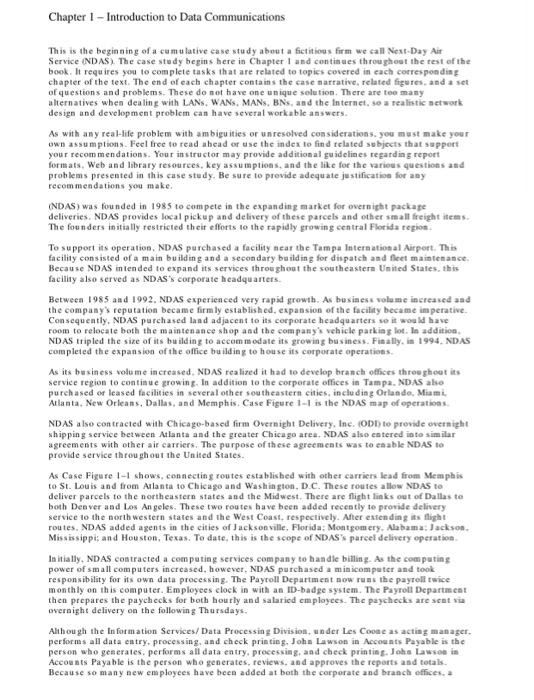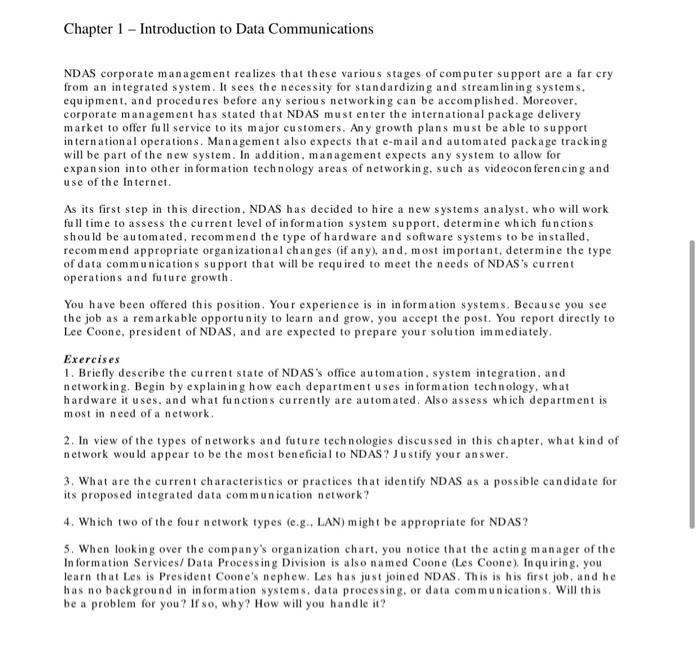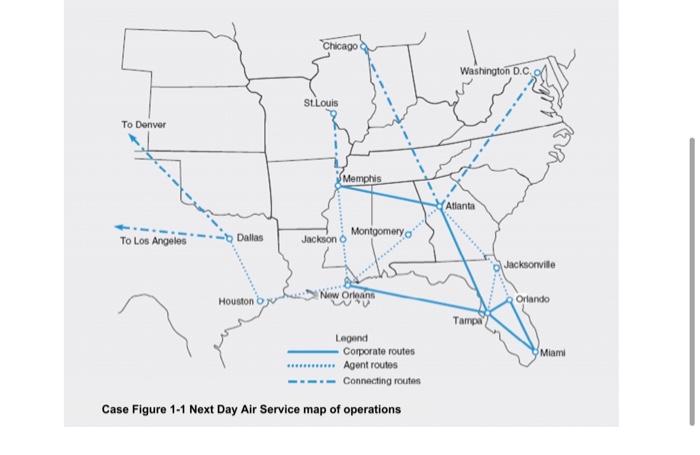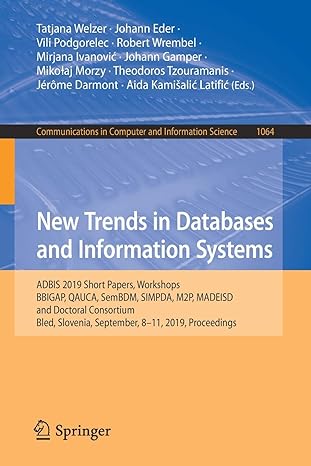Chapter 1 - Introduction to Data Communications This is the beginning of a cumulative case study about a fictitious firm we call Next Day Ait Service NDAS). The case study begins here in Chapter 1 and continues throughout the rest of the book. It requires you to complete tasks that are related to topics covered in cach corresponding chapter of the text. The end of each chapter contains the case narrative, related figures, and a set of questions and problems. These do not have one unique solution. There are too many alternatives when dealing with LAN, WAN, MAN, BNs, and the Internet, so a realistic network design and development problem can have several workable answers As with any real-life problem with ambiguities or unresolved considerations, you must make your own assumptions. Feel free to read ahead or use the index to find related subjects that support your recommendations. Your instructor may provide additional guidelines regarding report formats, Web and library resources, key assumptions, and the like for the various questions and problems presented in this case study. Be sure to provide adequate justification for any recommendations you make. (NDAS) was founded in 1985 to compete in the expanding market for overnight package deliveries. NDAS provides local pickup and delivery of these parcels and other small freight items. The founders initially restricted their efforts to the rapidly growing central Florida region To support its operation, NDAS purchased a facility near the Tampa International Airport. This facility consisted of a main building and a secondary building for dispatch and fleet maintenance Because NDAS intended to expand its services throughout the southeastern United States, this facility also served as NDAS' corporate headquarters Between 1985 and 1992. NDAS experienced very rapid growth. As business volume increased and the company's reputation became firmly established, expansion of the facility became imperative Consequently, NDAS purchased land adjacent to its corporate headquarters so it would have room to relocate both the maintenance shop and the company vehicle parking lot. In addition NDAS tripled the site of its building to accommodate its growing business. Finally, in 1994. NDAS completed the expansion of the office building to house its corporate operations As its business volume increased. NDAS realised it had to develop branch offices throughout its service region to continue growing. In addition to the corporate offices in Tampa. NDAS aho purchased or leased facilities in several other southeastern cities, including Orlando, Miami Atlanta, New Orleans, Dallas, and Memphis. Case Figure 1-1 is the NDAS map of operations NDAS also contracted with Chicago-based firm Overnight Delivery, Inc. ODI) to provide overnight shipping service between Atlanta and the greater Chicago area. NDAS also entered into similar agreements with other air carriers. The purpose of these agreements was to enable NDAS to provide service throughout the United States. As Case Figure 1-1 shows, connecting routes established with other carriers lead from Memphis to St. Louis and from Atlanta to Chicago and Washington, D.C. These routes allow NDAS DO deliver parcels to the northeastern states and the Midwest. There are flight links out of Dallas to both Denver and Los Angeles. These two routes have been added recently to provide delivery service to the north western states and the West Coast, respectively. After extending its flight routes. NDAS added agents in the cities of Jacksonville, Florida: Montgomery, Alabama: Jackson Mississippi, and Houston, Texas. To date, this is the scope of NDAS's parcel delivery operation Initially. NDAS contracted a computing services company to handle billing. As the computing power of small computers increased, however. NDAS purchased a minicomputer and took responsibility for its own data processing. The Payroll Department now runs the payroll twice monthly on this computer. Employees clock in with an ID-badge system. The Payroll Department then prepares the paychecks for both hourly and salaried employees. The paychecks are sent a overnight delivery on the following Thursdays. Although the information Services/Data Processing Division, under Les Coone as acting manager, performs all data entry processing, and check printing, John Lawson in Accounts Payable is the person who generates, performs all data entry, processing, and check printing. Joha Lawson in Accounts Payable is the person who generates, reviews, and approves the reports and totals. Because so many new employees have been added at both the corporate and branch offices. Chapter 1 - Introduction to Data Communications new full-time position has been added in Accounts Payable to handle the payroll and assist Lawson. The subject of paying employees weekly has been discussed as well. Case Figure 1-2 shows the NDAS organization chart The branch offices currently batch all billing data by order date and send them daily by overnight delivery to the corporate office along with other interoffice correspondence. When Information Services/ Data Processing receives the packages, it enters the batches and processes them daily The billing processing normally takes place from 48 to 96 hours after freight and parcel delivery Once this processing has been completed, the database supports the resolution of any questions or problems associated with the billings Because of an increasing volume of paperwork brought about by continued business expansion the varying complexity of the billing process and the preferred rates being given by competitors. NDAS's corporate management has decided to automate the billing process throughout its Florida offices. This is the first step in a series of strategic moves planned to provide online transaction processing and real-time customer information through the Internet. Management expects online transaction processing to speed the billing process and improve receivables collection time significantly. The online query system will enable agents at remote offices to obtain information such as credit status, correct delivery address, and package delivery status. The Internet component will enable customers to obtain the delivery status of packages they have sent or are expecting to receive The status of automation varies greatly among the various departments. The Marketing and Sales Division, headed by Bob Jones, has a personal computer (PC) for each account representative. All of these computers are connected to a small LAN that serves only Sales and Marketing The Accounts Receivable Division, headed by Jane Van Dyke, is responsible for all billing and collection activities. It recently replaced its aging minicomputer with a powerful microcomputer server. This new server provides databases for both customer billing and bad debts. The Accounts Payable Division, led by John Lawson, maintains its own vendor database that is stored on an older minicomputer server. This database also contains the other service carriers billings, such as these from ODI to NDAS. This division also is responsible for the payroll. It is in the process of downsizing to a powerful modern desktop computer. Employees in the Accounts Receivable and Payable Divisions have PCs on their desk. The Fleet Maintenance Division has no computer capability. Its management has chosen to trace all necessary information manually, Peter Browne, the maintenance supervisor, prefers this mode of operation and has steadfastly refused to automate bis division's recordkeeping processes. Dispatch, which is part of the Fleet Maintenance Division, also processes its work manually. Dispatch currently bundles in coming packages twice daily, according to their major destination point, for overnight delivery. The bundles of packages are marked with the following information: DEST: City, state DATE: Current date TIME: Time package left dispatch NPKG: Number of individual packages in the bundle INT: Initials of the person preparing the bundle When the bundles arrive at their respective delivery points, the off-loaders mark the arrival time on the bundles'tags, write their own initials on the back of the tags, and return the tags to corporate headquarters. The packages are then delivered The various remote offices currently communicate with the corporate headquarters and with one another by voice mail, telephone, fax, mail, or interoffice mail, sent on company aircraft along with the daily batched transactions. There are desktop computers in each of the remote offices However, some of the offices have Apple Macintosh computers and others use Intel-based systems. A number of managers have laptop computers with wireless and wised networking capabilities, which, again, come from various computer manufacturers Chapter 1 - Introduction to Data Communications NDAS corporate management realizes that these various stages of computer support are a far cry from an integrated system. It sees the necessity for standardizing and stream lining systems, equipment, and procedures before any serious networking can be accomplished. Moreover, corporate management has stated that NDAS must enter the international package delivery market to offer full service to its major customers. Any growth plans must be able to support international operations. Management also expects that e-mail and automated package tracking will be part of the new system. In addition, management expects any system to allow for expansion into other information technology areas of networking, such as videoconferencing and use of the Internet As its first step in this direction. NDAS has decided to hire a new systems analyst, who will work full time to assess the current level of information system support, determine which functions should be automated, recommend the type of hardware and software systems to be installed, recommend appropriate organizational changes (if any), and, most important, determine the type of data communications support that will be required to meet the needs of NDAS's current operations and future growth You have been offered this position. Your experience is in information systems. Because you see the job as a remarkable opportunity to learn and grow. you accept the post. You report directly to Lee Coone, president of NDAS, and are expected to prepare your solution immediately Exercises 1. Briefly describe the current state of NDAS's office automation system integration, and networking. Begin by explaining how cach department uses information technology, what hardware it uses, and what functions currently are automated. Also assess which department is most in need of a network 2. In view of the types of networks and future technologies discussed in this chapter, what kind of network would appear to be the most beneficial to NDAS? Justify your answer. 3. What are the current characteristics or practices that identify NDAS as a possible candidate for its proposed integrated data communication network? 4. Which two of the four network types (e.g., LAN) might be appropriate for NDAS? 5. When looking over the company's organization chart, you notice that the acting manager of the Information Services/ Data Processing Division is also named Coone (Les Coone). Inquiring, you learn that Les is President Coone's nephew. Les has just joined NDAS. This is his first job, and he has no background in information systems, data processing, or data communications. Will this be a problem for you? If so, why? How will you handle it? Chicago Washington DC St Louis To Denver Memphis Atlanta To Los Angeles Dallas Montgomery Jackson Jacksonville Now Orleans Houston Orlando Tampa Miami Legend Corporate routes Agent routes Connecting routes Case Figure 1-1 Next Day Air Service map of operations Chapter 1 - Introduction to Data Communications This is the beginning of a cumulative case study about a fictitious firm we call Next Day Ait Service NDAS). The case study begins here in Chapter 1 and continues throughout the rest of the book. It requires you to complete tasks that are related to topics covered in cach corresponding chapter of the text. The end of each chapter contains the case narrative, related figures, and a set of questions and problems. These do not have one unique solution. There are too many alternatives when dealing with LAN, WAN, MAN, BNs, and the Internet, so a realistic network design and development problem can have several workable answers As with any real-life problem with ambiguities or unresolved considerations, you must make your own assumptions. Feel free to read ahead or use the index to find related subjects that support your recommendations. Your instructor may provide additional guidelines regarding report formats, Web and library resources, key assumptions, and the like for the various questions and problems presented in this case study. Be sure to provide adequate justification for any recommendations you make. (NDAS) was founded in 1985 to compete in the expanding market for overnight package deliveries. NDAS provides local pickup and delivery of these parcels and other small freight items. The founders initially restricted their efforts to the rapidly growing central Florida region To support its operation, NDAS purchased a facility near the Tampa International Airport. This facility consisted of a main building and a secondary building for dispatch and fleet maintenance Because NDAS intended to expand its services throughout the southeastern United States, this facility also served as NDAS' corporate headquarters Between 1985 and 1992. NDAS experienced very rapid growth. As business volume increased and the company's reputation became firmly established, expansion of the facility became imperative Consequently, NDAS purchased land adjacent to its corporate headquarters so it would have room to relocate both the maintenance shop and the company vehicle parking lot. In addition NDAS tripled the site of its building to accommodate its growing business. Finally, in 1994. NDAS completed the expansion of the office building to house its corporate operations As its business volume increased. NDAS realised it had to develop branch offices throughout its service region to continue growing. In addition to the corporate offices in Tampa. NDAS aho purchased or leased facilities in several other southeastern cities, including Orlando, Miami Atlanta, New Orleans, Dallas, and Memphis. Case Figure 1-1 is the NDAS map of operations NDAS also contracted with Chicago-based firm Overnight Delivery, Inc. ODI) to provide overnight shipping service between Atlanta and the greater Chicago area. NDAS also entered into similar agreements with other air carriers. The purpose of these agreements was to enable NDAS to provide service throughout the United States. As Case Figure 1-1 shows, connecting routes established with other carriers lead from Memphis to St. Louis and from Atlanta to Chicago and Washington, D.C. These routes allow NDAS DO deliver parcels to the northeastern states and the Midwest. There are flight links out of Dallas to both Denver and Los Angeles. These two routes have been added recently to provide delivery service to the north western states and the West Coast, respectively. After extending its flight routes. NDAS added agents in the cities of Jacksonville, Florida: Montgomery, Alabama: Jackson Mississippi, and Houston, Texas. To date, this is the scope of NDAS's parcel delivery operation Initially. NDAS contracted a computing services company to handle billing. As the computing power of small computers increased, however. NDAS purchased a minicomputer and took responsibility for its own data processing. The Payroll Department now runs the payroll twice monthly on this computer. Employees clock in with an ID-badge system. The Payroll Department then prepares the paychecks for both hourly and salaried employees. The paychecks are sent a overnight delivery on the following Thursdays. Although the information Services/Data Processing Division, under Les Coone as acting manager, performs all data entry processing, and check printing, John Lawson in Accounts Payable is the person who generates, performs all data entry, processing, and check printing. Joha Lawson in Accounts Payable is the person who generates, reviews, and approves the reports and totals. Because so many new employees have been added at both the corporate and branch offices. Chapter 1 - Introduction to Data Communications new full-time position has been added in Accounts Payable to handle the payroll and assist Lawson. The subject of paying employees weekly has been discussed as well. Case Figure 1-2 shows the NDAS organization chart The branch offices currently batch all billing data by order date and send them daily by overnight delivery to the corporate office along with other interoffice correspondence. When Information Services/ Data Processing receives the packages, it enters the batches and processes them daily The billing processing normally takes place from 48 to 96 hours after freight and parcel delivery Once this processing has been completed, the database supports the resolution of any questions or problems associated with the billings Because of an increasing volume of paperwork brought about by continued business expansion the varying complexity of the billing process and the preferred rates being given by competitors. NDAS's corporate management has decided to automate the billing process throughout its Florida offices. This is the first step in a series of strategic moves planned to provide online transaction processing and real-time customer information through the Internet. Management expects online transaction processing to speed the billing process and improve receivables collection time significantly. The online query system will enable agents at remote offices to obtain information such as credit status, correct delivery address, and package delivery status. The Internet component will enable customers to obtain the delivery status of packages they have sent or are expecting to receive The status of automation varies greatly among the various departments. The Marketing and Sales Division, headed by Bob Jones, has a personal computer (PC) for each account representative. All of these computers are connected to a small LAN that serves only Sales and Marketing The Accounts Receivable Division, headed by Jane Van Dyke, is responsible for all billing and collection activities. It recently replaced its aging minicomputer with a powerful microcomputer server. This new server provides databases for both customer billing and bad debts. The Accounts Payable Division, led by John Lawson, maintains its own vendor database that is stored on an older minicomputer server. This database also contains the other service carriers billings, such as these from ODI to NDAS. This division also is responsible for the payroll. It is in the process of downsizing to a powerful modern desktop computer. Employees in the Accounts Receivable and Payable Divisions have PCs on their desk. The Fleet Maintenance Division has no computer capability. Its management has chosen to trace all necessary information manually, Peter Browne, the maintenance supervisor, prefers this mode of operation and has steadfastly refused to automate bis division's recordkeeping processes. Dispatch, which is part of the Fleet Maintenance Division, also processes its work manually. Dispatch currently bundles in coming packages twice daily, according to their major destination point, for overnight delivery. The bundles of packages are marked with the following information: DEST: City, state DATE: Current date TIME: Time package left dispatch NPKG: Number of individual packages in the bundle INT: Initials of the person preparing the bundle When the bundles arrive at their respective delivery points, the off-loaders mark the arrival time on the bundles'tags, write their own initials on the back of the tags, and return the tags to corporate headquarters. The packages are then delivered The various remote offices currently communicate with the corporate headquarters and with one another by voice mail, telephone, fax, mail, or interoffice mail, sent on company aircraft along with the daily batched transactions. There are desktop computers in each of the remote offices However, some of the offices have Apple Macintosh computers and others use Intel-based systems. A number of managers have laptop computers with wireless and wised networking capabilities, which, again, come from various computer manufacturers Chapter 1 - Introduction to Data Communications NDAS corporate management realizes that these various stages of computer support are a far cry from an integrated system. It sees the necessity for standardizing and stream lining systems, equipment, and procedures before any serious networking can be accomplished. Moreover, corporate management has stated that NDAS must enter the international package delivery market to offer full service to its major customers. Any growth plans must be able to support international operations. Management also expects that e-mail and automated package tracking will be part of the new system. In addition, management expects any system to allow for expansion into other information technology areas of networking, such as videoconferencing and use of the Internet As its first step in this direction. NDAS has decided to hire a new systems analyst, who will work full time to assess the current level of information system support, determine which functions should be automated, recommend the type of hardware and software systems to be installed, recommend appropriate organizational changes (if any), and, most important, determine the type of data communications support that will be required to meet the needs of NDAS's current operations and future growth You have been offered this position. Your experience is in information systems. Because you see the job as a remarkable opportunity to learn and grow. you accept the post. You report directly to Lee Coone, president of NDAS, and are expected to prepare your solution immediately Exercises 1. Briefly describe the current state of NDAS's office automation system integration, and networking. Begin by explaining how cach department uses information technology, what hardware it uses, and what functions currently are automated. Also assess which department is most in need of a network 2. In view of the types of networks and future technologies discussed in this chapter, what kind of network would appear to be the most beneficial to NDAS? Justify your answer. 3. What are the current characteristics or practices that identify NDAS as a possible candidate for its proposed integrated data communication network? 4. Which two of the four network types (e.g., LAN) might be appropriate for NDAS? 5. When looking over the company's organization chart, you notice that the acting manager of the Information Services/ Data Processing Division is also named Coone (Les Coone). Inquiring, you learn that Les is President Coone's nephew. Les has just joined NDAS. This is his first job, and he has no background in information systems, data processing, or data communications. Will this be a problem for you? If so, why? How will you handle it? Chicago Washington DC St Louis To Denver Memphis Atlanta To Los Angeles Dallas Montgomery Jackson Jacksonville Now Orleans Houston Orlando Tampa Miami Legend Corporate routes Agent routes Connecting routes Case Figure 1-1 Next Day Air Service map of operations










